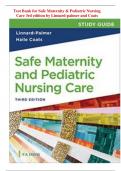Summary
ABCDE voor verpleegkundigen Asaf Gafni & Eveline Heesterbeek samenvatting hoofdstuk 4 C (Circulation)
- Course
- Institution
- Book
Samenvatting van hoofdstuk 4 C (Circulation) van het boek ABCDE voor verpleegkundigen van Asaf Gafni & Eveline Heesterbeek. Gemaakt tijdens het volgen van de minor Acute zorg op Saxion Hogeschool in leerjaar .
[Show more]













